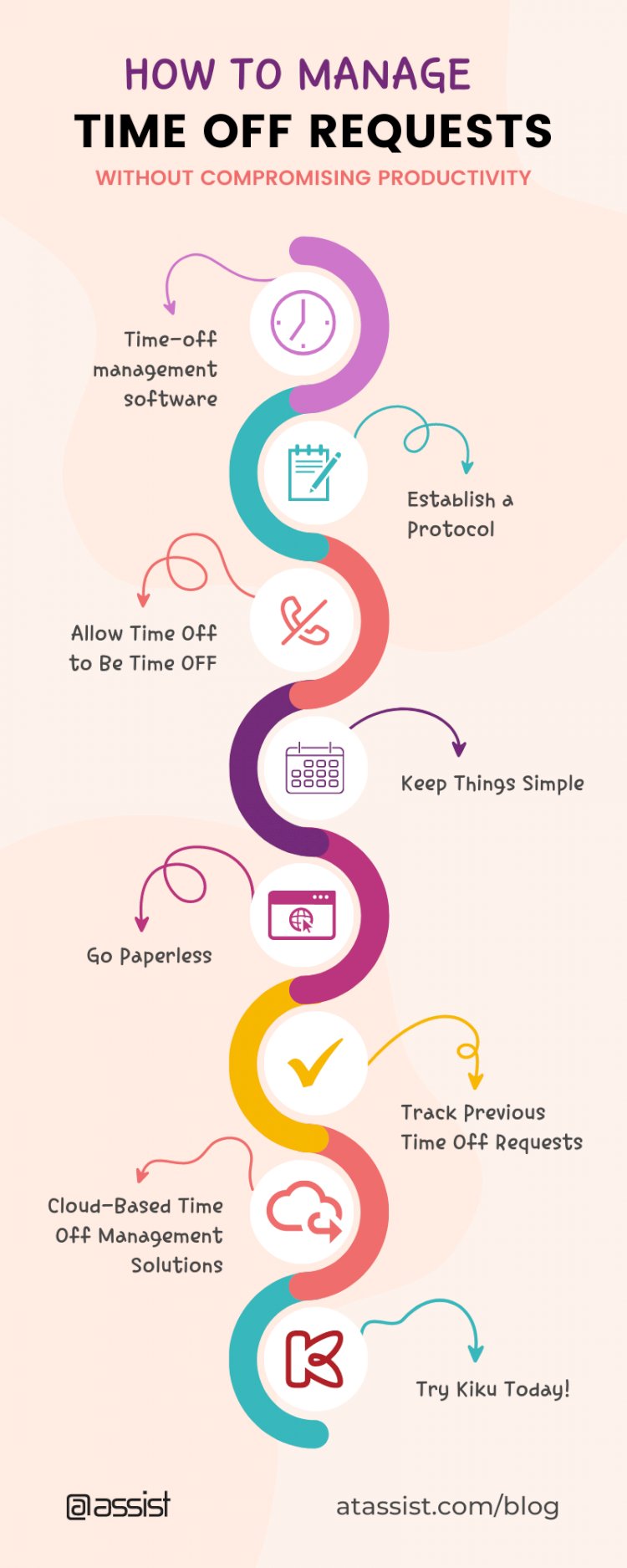How to Manage Time Off Requests Without Compromising Productivity
Time off management sounds easy, but can be an intricate one. One of the most important responsibilities of a manager is to manage employee time-off requests while balancing company deadlines as well as accommodating the team and their needs. Managing employee time-off requests effectively can help maintain a more positive work environment and ultimately help the company succeed.

One of the most important responsibilities of a manager is to manage employee time-off requests while balancing company deadlines as well as accommodating the team and their needs. Managing employee time-off requests effectively can help maintain a more positive work environment and ultimately help the company succeed.
As a manager, you may feel overwhelmed when seeing those time off requests roll in, especially right before the holidays or summer vacations. Thankfully, there are numerous solutions that a company can implement in order to approve time off requests without compromising their business’s productivity.
Here are a few easy tips to stay on top of the job without losing sleep.
Establish a Protocol
In a perfect world where the days are always sunny and our coffee is always hot, employees would be able to book their vacation days anytime they’d like. However, this can be tricky as companies rely heavily on their employees for daily business needs.

Due to this, many companies have attempted to solve this issue by implementing a PTO protocol that all employees are made aware of.
By creating a new protocol for time off requests, your company will create a mutually beneficial agreement between management and employees. Try creating a set of rules that are fair and realistic for employees to follow.
An example would be asking employees to submit their time off requests at least 2 months in advance.
These types of regulations will ensure that managers will no longer have to worry about supporting certain departments due to lack of staff and employees will never feel hesitant or unsure about the guidelines surrounding their vacation approval.
Both parties will have access to the protocol, which will create transparency throughout the entire team.
Of course, businesses can’t always predict sick days, maternity/paternity leave, mental health days, and emergencies; however, with a pre-established protocol surrounding time off; these last-minute occurrences won’t seem as prevalent.
Another significant consideration to include in your time off protocol is how managers should approach overlapping requests. Many companies, especially larger scale organizations, may often find that multiple employees are requesting time off on the same days.
By establishing transparent rules regarding this occurrence (eg. a first come first serve approach or choosing based on seniority) employees will be made aware of the circumstances surrounding their time off prior to submitting a request. This will also motivate your staff to be proactive with their requests which will benefit management by giving them an abundance of time to prepare for their leave.
Allow Time Off to Be Time Off
The expectation for all employees is that they produce great quality work and provide constant communication during work hours. To balance out this notion, employees should have full ownership of their days off and should enjoy their time off in whichever way they prefer. By allowing employees to enjoy their time off without any requirements to check their work email, companies will see an exponential boost in morale.

According to Forbes, employees who have just returned from vacation are more likely to return in better spirits which positively affects their work quality and productivity.
Companies should view time off as a beneficial experience for their employees and the business's success. Having a positive and encouraging attitude towards time off requests will allow employees to feel comfortable when asking for time off, and will motivate managers to confidently accept.
Keep Things Simple
When a manager sees a pile of time off requests laying on their desk, they may feel tense and under pressure to approve them while also ensuring the work will get done.
By utilizing technology, this process can be made a lot less challenging for managers (while also saving them time). Consider setting up an online calendar that the entire team can view, or trying different software that will do all the work for you!
When an employee’s time off request is approved, the calendar will automatically update to reflect this new event and the entire team will be notified. This will allow departments to adjust their workload accordingly.
Go Paperless
Nothing screams stress louder than 30 paper time off slips shoved into your work mailbox or left unorganized on your desk.
Paper forms and slips were an office staple years ago; however, with technology being more accessible now than ever before, the mass usage of paper has become unnecessary.
Many companies have opted to go paperless and transition to a fully digital office. Going paperless can benefit the workplace by reducing clutter, improving organization, enhancing communication and productivity, reducing supply costs, and helping the environment.
Handling time off requests virtually eliminates the risk of losing any requests and ensures that there is a digital trace of all communications that have taken place.
This will also help tremendously with payroll as HR managers will no longer have to spend time searching an endless amount of paperwork — everything they could possibly need will be accessible with just a few clicks.
With time off management software, your team will see a big improvement in a myriad of ways. Not only will the process of submitting and approving time-off be substantially quicker, but it will also be easier for management to realistically view the upcoming months with help from the online calendar.
Additionally, digital time off requests will make paper forms obsolete; aiding the environment and creating a cleaner and more efficient environment for everyone.
Track Previous Time Off Requests
As a manager, you already have copious amounts of deadlines to meet, contracts to sign, and meetings to attend. On top of that heavy workload, HR managers have the added responsibility of keeping track of past vacation days in order to have an accurate payroll. This is a large undertaking especially if the company is still using paper as their main form of documentation which can lead to a time-consuming process of tracking down certain documents and potentially cause errors in payroll.
Transferring to cloud-based software can drastically improve the entire time off management process by storing all the crucial information online. An additional perk is that management will now be able to make more informed decisions in regards to approving or denying employee requests by being able to spot patterns. If an employee is too nervous to ask for time off and they have accumulated a large amount of PTO, a manager would be able to approach this individual and encourage them to book time off.
The easiest and most effective way to manage time off requests without compromising your business needs is by investing in time off software. Time off software gives management the tools needed to make well-informed decisions surrounding PTO. From the comfort of your desk, you can receive a notification for a time off request, glance at the internal calendar to view the appropriate days, and with a single click of a button, you can approve or deny the request.
Cloud-Based Time Off Management Solution
Kiku manages all of your time off requests in one cloud-based solution that is easy for both managers and employees to access. Request time off, customize leave, celebrate birthdays, work anniversaries, and more, all with Kiku integrated into Slack! Get your 14-day Kiku free trial today!

 contact@atassist.com
contact@atassist.com 





